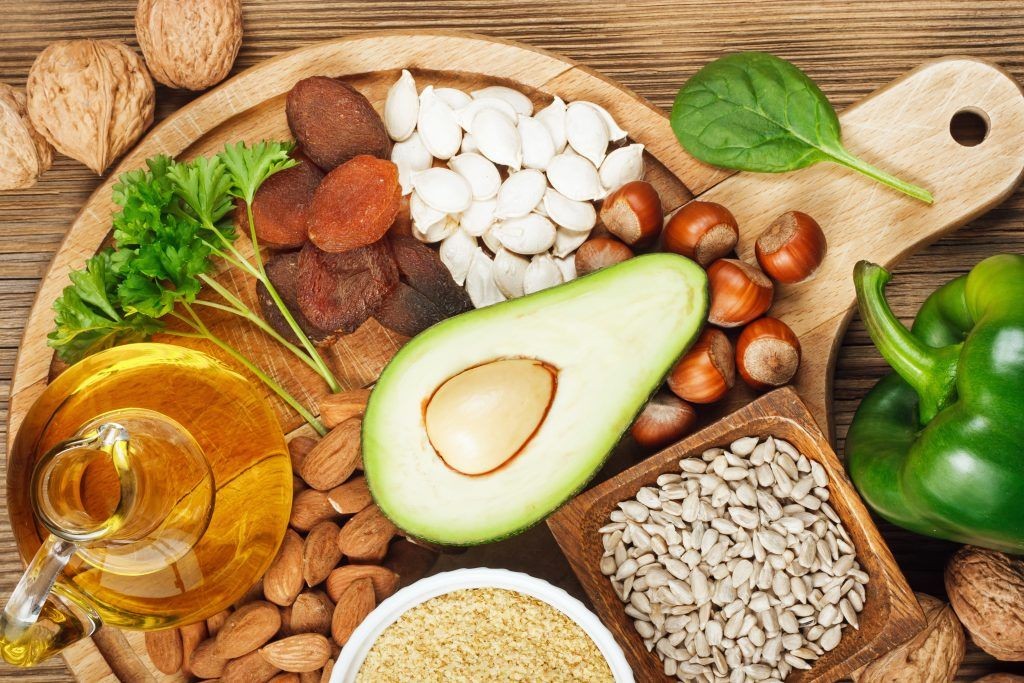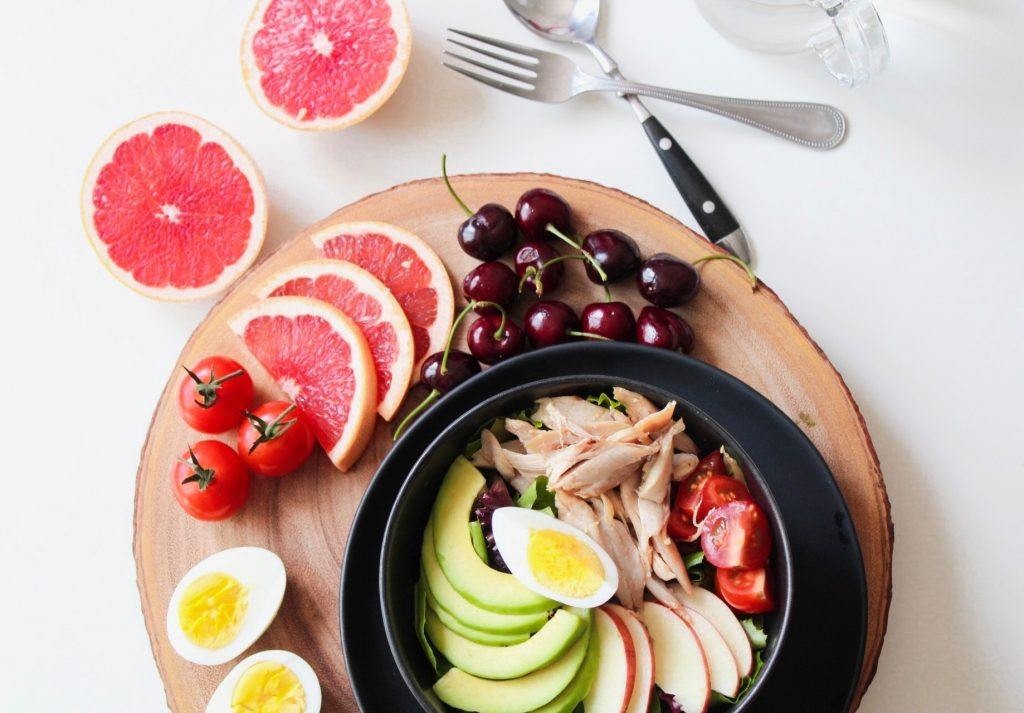Unlock the power of Vitamin E with FOODS.EDU.VN! Discover which foods are packed with this essential nutrient, explore its benefits, and learn how to incorporate them into your diet for optimal health. This guide provides expert-backed insights, ensuring you receive accurate information to enhance your well-being.
1. Understanding Vitamin E: The Antioxidant Powerhouse
Vitamin E, a fat-soluble vitamin, is celebrated for its antioxidant properties, which protect your body from damage caused by free radicals. It exists in eight different forms, with alpha-tocopherol being the most active form utilized by the human body. This powerful nutrient not only combats oxidative stress but also supports immune function and prevents blood clot formation, making it an essential component of a healthy diet. Its antioxidant capabilities safeguard cells from free radical damage and reduce their production in specific situations, bolstering overall health.
2. Recommended Daily Intake of Vitamin E
To maintain optimal health, it’s crucial to understand the recommended daily allowance (RDA) of vitamin E. According to the National Institutes of Health, the RDA for adults aged 14 and older is 15 mg (22.4 IU). This includes pregnant women, while lactating women require slightly more, around 19 mg (28.4 IU) daily. Meeting these recommendations helps ensure your body has enough vitamin E to perform its vital functions. Here’s a simple breakdown for different life stages:
| Age Group | Recommended Daily Allowance (RDA) |
|---|---|
| 14+ years (including pregnant women) | 15 mg (22.4 IU) |
| Lactating women | 19 mg (28.4 IU) |




3. Top Foods Rich in Vitamin E: A Culinary Treasure Hunt
Vitamin E is abundant in a variety of foods, making it easy to incorporate into your daily meals. Plant-based oils, nuts, seeds, fruits, and vegetables are excellent sources. FOODS.EDU.VN offers a wide range of recipes that highlight these ingredients, making it simple and enjoyable to increase your vitamin E intake.
- Plant-Based Oils: Wheat germ oil, sunflower oil, safflower oil, and soybean oil
- Nuts and Seeds: Almonds, peanuts, peanut butter, sunflower seeds, pumpkin seeds
- Vegetables: Beet greens, collard greens, spinach, red bell pepper, asparagus
- Fruits: Mangoes, avocados
- Other: Fortified cereals, such as Total, Special K, and Raisin Bran
4. Spotlight on Key Vitamin E-Rich Foods
Let’s dive deeper into some of the most potent sources of vitamin E and how they can benefit your health.
4.1. Wheat Germ Oil: A Concentrated Source
Wheat germ oil is one of the most concentrated sources of vitamin E. Just one tablespoon provides more than 100% of the recommended daily intake. Use it in salad dressings or as a finishing oil to boost your vitamin E levels effortlessly.
4.2. Nuts and Seeds: Snack Smart
Almonds, sunflower seeds, and peanuts are not only delicious snacks but also excellent sources of vitamin E. A handful of almonds can contribute significantly to your daily needs, making them a convenient and healthy choice.
4.3. Leafy Greens: A Nutritional Powerhouse
Spinach, beet greens, and collard greens are packed with vitamins and minerals, including vitamin E. Incorporate these leafy greens into your salads, smoothies, or side dishes for a nutritional boost.
4.4. Avocado: Creamy and Nutritious
Avocado is a versatile fruit that is rich in vitamin E and healthy fats. Add it to your toast, salads, or smoothies for a creamy texture and a dose of essential nutrients.
4.5. Fortified Foods: An Easy Boost
Many breakfast cereals and other foods are fortified with vitamin E, providing an easy way to meet your daily requirements. Check the nutrition labels to find fortified options that fit your dietary preferences.
5. Recognizing Vitamin E Deficiency: What to Watch For
Vitamin E deficiency is rare in healthy individuals who consume a balanced diet. However, certain conditions can increase the risk of deficiency. Understanding the signs and risk factors is crucial for maintaining your health.
5.1. Risk Factors for Vitamin E Deficiency
- Digestive Disorders: Conditions like pancreatitis, cystic fibrosis, and celiac disease can impair fat absorption, leading to vitamin E deficiency.
- Premature Infants: Premature babies often have lower vitamin E levels and may require supplementation.
- Genetic Disorders: Certain genetic conditions can affect vitamin E absorption and utilization.
5.2. Common Symptoms of Vitamin E Deficiency
- Muscle Weakness: Vitamin E is essential for muscle function, and deficiency can lead to muscle weakness.
- Vision Problems: Retinopathy, or damage to the retina, can impair vision and is a sign of severe deficiency.
- Nerve Damage: Peripheral neuropathy can cause weakness, numbness, and pain in the hands and feet.
- Impaired Immunity: Vitamin E supports immune function, and deficiency can increase susceptibility to infections.
- Ataxia: Loss of control of body movements
6. Potential Benefits of Vitamin E: A Deep Dive into Research
Vitamin E has been studied extensively for its potential health benefits. While research is ongoing, here are some of the promising areas where vitamin E may play a role:
6.1. Heart Health: Protecting Your Cardiovascular System
Vitamin E’s antioxidant properties may help protect against cardiovascular disease by preventing the oxidation of LDL cholesterol. Oxidized LDL cholesterol can contribute to plaque formation in arteries, increasing the risk of heart attacks and strokes. A meta-analysis published in the “American Journal of Clinical Nutrition” showed that higher vitamin E intake was associated with a reduced risk of coronary heart disease in women. The U.S. Preventive Services Task Force’s 2022 review of evidence from clinical trials found no conclusive benefit of vitamin E supplements for the prevention of cardiovascular disease, and therefore recommended against their use.
6.2. Cancer Prevention: Exploring the Evidence
Some studies suggest that vitamin E may help protect against certain types of cancer. Its antioxidant properties can neutralize free radicals, which can damage DNA and contribute to cancer development. For example, a study published in the “Journal of the National Cancer Institute” found that higher vitamin E intake was associated with a reduced risk of prostate cancer. However, the U.S. Preventive Services Task Force’s 2022 review of the evidence from clinical trials on the efficacy of vitamin E for cancer also showed no benefit of these supplements on a decreased incidence of or deaths from any cancer. Observational studies (Willett et al.,1984; Hunter et al., 1993; Chan et al., 1999; van Dam et al., 2000; Wu et al., 2002; Fung et al., 2003; Feskanich et al., 2003; Cho et al., 2003; Cho et al., 2006; Lee et al., 2006) have not found that vitamin E in food or supplements offers much protection against cancer in general, or against specific cancers.
6.3. Eye Health: Protecting Your Vision
Vitamin E, along with other antioxidants, may help protect against age-related macular degeneration (AMD) and cataracts. A study published in the “Archives of Ophthalmology” found that a combination of vitamin E, vitamin C, beta-carotene, and zinc reduced the risk of advanced AMD in high-risk individuals. A six-year trial found that vitamin E, in combination with vitamin C, beta carotene, and zinc, offered some protection against the development of advanced age-related macular degeneration (AMD), but not cataracts, in people who were at high risk of the disease. On its own, however, vitamin E does not seem to offer much benefit against either AMD or cataracts.
6.4. Cognitive Function: Supporting Brain Health
Emerging research suggests that vitamin E may play a role in cognitive function and neurodegenerative diseases. Its antioxidant properties may help protect brain cells from damage, potentially reducing the risk of cognitive decline. Some prospective studies (Grodstein et al., 2003; Zandi et al., 2004) suggest that vitamin E supplements, particularly in combination with vitamin C, may be associated with small improvements in cognitive function or lowered risk of Alzheimer’s disease and other forms of dementia, while other studies (Laurin et al., 2004; Gray et al., 2008; Devore et al., 2013) have failed to find any such benefit. A three-year randomized controlled trial in people with mild cognitive impairment—often a precursor to Alzheimer’s disease—found that taking 2,000 IU of vitamin E daily failed to slow the progression to Alzheimer’s disease.
7. Vitamin E Supplementation: Is It Necessary?
While vitamin E is widely available in foods, many people turn to supplements to ensure they meet their daily requirements. However, it’s essential to approach supplementation with caution.
7.1. Considerations for Supplementation
- Consult a Healthcare Professional: Before starting any new supplement, it’s crucial to consult with a doctor or registered dietitian. They can assess your individual needs and determine if supplementation is necessary.
- Choose the Right Form: Vitamin E supplements come in various forms, including alpha-tocopherol and mixed tocopherols. Alpha-tocopherol is the most active form, but mixed tocopherols may offer additional benefits.
- Dosage: Stick to the recommended dosage on the supplement label, and avoid exceeding the upper limit of 1,000 mg (1,465 IU) per day.
7.2. Potential Risks of Excessive Vitamin E Intake
- Bleeding Risk: High doses of vitamin E can interfere with blood clotting, increasing the risk of bleeding, especially in individuals taking blood-thinning medications like warfarin.
- Drug Interactions: Vitamin E supplements can interact with certain medications, including aspirin, tamoxifen, and cyclosporine.
- Other Side Effects: Although rare, some people may experience nausea, diarrhea, or fatigue when taking high doses of vitamin E.
8. Creative Ways to Incorporate Vitamin E into Your Diet
Making simple changes to your diet can significantly increase your vitamin E intake. Here are some creative ideas to get you started:
8.1. Breakfast Boost
- Add a tablespoon of wheat germ oil to your morning smoothie.
- Sprinkle sunflower seeds or chopped almonds on your oatmeal or yogurt.
- Choose a fortified breakfast cereal rich in vitamin E.
8.2. Lunchtime Enhancements
- Include a handful of spinach or beet greens in your salad.
- Add avocado slices to your sandwiches or wraps.
- Use sunflower oil or safflower oil in your homemade salad dressings.
8.3. Dinner Delights
- Roast vegetables like red bell peppers and asparagus with olive oil.
- Prepare a stir-fry with tofu, spinach, and a variety of colorful vegetables.
- Snack on almonds or peanuts while preparing dinner.
8.4. Snacking Sensibly
- Enjoy a handful of almonds or sunflower seeds as a mid-afternoon snack.
- Make a trail mix with nuts, seeds, and dried fruits.
- Spread peanut butter on whole-grain crackers or apple slices.
9. Debunking Common Myths About Vitamin E
There are several misconceptions surrounding vitamin E. Let’s set the record straight:
9.1. Myth: More Vitamin E is Always Better
Fact: While vitamin E is essential for health, consuming excessive amounts can lead to adverse effects. Stick to the recommended daily intake and avoid exceeding the upper limit.
9.2. Myth: Vitamin E Supplements Can Cure Diseases
Fact: While some studies suggest potential benefits of vitamin E for certain conditions, it is not a cure-all. Vitamin E supplements should be used as part of a comprehensive treatment plan under the guidance of a healthcare professional.
9.3. Myth: All Forms of Vitamin E Are Equally Effective
Fact: Alpha-tocopherol is the most active form of vitamin E in the human body, but other forms, such as gamma-tocopherol, may offer additional benefits.
10. Latest Research and Trends in Vitamin E Studies
Stay informed about the cutting-edge research and emerging trends in vitamin E studies. Here’s a snapshot of recent developments:
| Topic | Findings | Source |
|---|---|---|
| Vitamin E and Gut Health | Recent studies suggest that vitamin E may play a role in maintaining gut health by modulating the gut microbiota and reducing inflammation. | “Journal of Nutritional Biochemistry” |
| Vitamin E and Skin Health | Research indicates that vitamin E can protect against UV-induced skin damage and promote wound healing due to its antioxidant and anti-inflammatory properties. | “Journal of the American Academy of Dermatology” |
| Vitamin E and Exercise Recovery | Some studies suggest that vitamin E supplementation may reduce muscle damage and improve recovery after intense exercise by reducing oxidative stress. | “International Journal of Sport Nutrition and Exercise Metabolism” |
| Vitamin E and Fertility | Vitamin E may play a role in reproductive health by protecting sperm and egg cells from oxidative damage. Studies are ongoing to explore the potential benefits of vitamin E for fertility treatments. | “Fertility and Sterility” |
| Vitamin E and Immune Function | Vitamin E is known to enhance immune function by supporting the activity of immune cells. Research is exploring the potential of vitamin E to boost immunity in older adults. | “American Journal of Clinical Nutrition” |
FAQ: Your Burning Questions About Vitamin E Answered
Here are some frequently asked questions about vitamin E:
- What is the best source of vitamin E?
Wheat germ oil, almonds, sunflower seeds, and avocados are excellent sources of vitamin E. - Can I get enough vitamin E from my diet alone?
Yes, you can typically get enough vitamin E from a balanced diet that includes a variety of vitamin E-rich foods. - Should I take a vitamin E supplement?
Consult with a healthcare professional before taking a vitamin E supplement. Supplementation may be beneficial for individuals with certain medical conditions or dietary restrictions. - What are the symptoms of vitamin E deficiency?
Symptoms of vitamin E deficiency can include muscle weakness, vision problems, nerve damage, and impaired immunity. - Can vitamin E interact with medications?
Yes, vitamin E can interact with certain medications, including blood thinners, aspirin, tamoxifen, and cyclosporine. - Is there an upper limit for vitamin E intake?
Yes, the upper limit for vitamin E intake is 1,000 mg (1,465 IU) per day for adults. - Can vitamin E prevent heart disease?
Some studies suggest that vitamin E may help protect against heart disease, but more research is needed. A heart-healthy diet and lifestyle are essential for cardiovascular health. - Can vitamin E protect against cancer?
Some studies suggest that vitamin E may help protect against certain types of cancer, but more research is needed. A healthy diet and lifestyle are essential for cancer prevention. - How can I incorporate more vitamin E into my meals?
Add wheat germ oil to smoothies, sprinkle nuts and seeds on salads, and include avocado in sandwiches and wraps. - Where can I find reliable information about vitamin E and nutrition?
FOODS.EDU.VN offers a wealth of expert-backed information about vitamin E and other essential nutrients.
Conclusion: Embrace the Power of Vitamin E
Vitamin E is a vital nutrient that plays a crucial role in maintaining your health. By understanding which foods are rich in vitamin E and incorporating them into your diet, you can unlock the antioxidant powerhouse and protect your body from damage.
Ready to dive deeper into the world of nutrition and healthy eating? Visit FOODS.EDU.VN today to discover a treasure trove of expert-backed articles, delicious recipes, and practical tips that will empower you to make informed choices and nourish your body from the inside out. Whether you’re seeking to optimize your vitamin intake, explore new culinary horizons, or simply enhance your overall well-being, FOODS.EDU.VN is your trusted guide on the path to a healthier, happier you. Don’t miss out on this opportunity to transform your relationship with food and unlock your full potential. Explore FOODS.EDU.VN now and embark on a journey of culinary discovery and wellness.
Contact us:
- Address: 1946 Campus Dr, Hyde Park, NY 12538, United States
- Whatsapp: +1 845-452-9600
- Website: foods.edu.vn